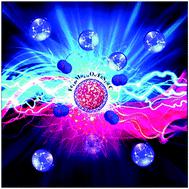当前位置:
X-MOL 学术
›
Green Chem.
›
论文详情
Our official English website, www.x-mol.net, welcomes your
feedback! (Note: you will need to create a separate account there.)
Polyoxometalate-based metal–organic framework-derived bimetallic hybrid materials for upgraded electrochemical reduction of nitrogen
Green Chemistry ( IF 9.3 ) Pub Date : 2020-08-18 , DOI: 10.1039/d0gc01149e Xinming Wang 1, 2, 3, 4 , Zemin Feng 1, 2, 3, 4 , Boxin Xiao 1, 2, 3, 4 , Jingxiang Zhao 5, 6, 7, 8, 9 , Huiyuan Ma 1, 2, 3, 4 , Yu Tian 4, 10, 11, 12 , Haijun Pang 1, 2, 3, 4 , Lichao Tan 1, 2, 3, 4
Green Chemistry ( IF 9.3 ) Pub Date : 2020-08-18 , DOI: 10.1039/d0gc01149e Xinming Wang 1, 2, 3, 4 , Zemin Feng 1, 2, 3, 4 , Boxin Xiao 1, 2, 3, 4 , Jingxiang Zhao 5, 6, 7, 8, 9 , Huiyuan Ma 1, 2, 3, 4 , Yu Tian 4, 10, 11, 12 , Haijun Pang 1, 2, 3, 4 , Lichao Tan 1, 2, 3, 4
Affiliation

|
The development of high-efficiency noble-metal-free catalysts for the electrochemical nitrogen reduction reaction (NRR) to ammonia under ambient conditions has great significance in fertilizer production and energy storage. Considering the major role of Mo-nitrogenase with the FeMo cofactor in the biological N2 fixation process, the design and preparation of Mo and Fe bi-active metal based hybrid materials for the NRR under ambient conditions is proposed in this work. By using PMo12@MOF-100(Fe)@PVP (polyvinylpyrrolidone) as the precursor, two cost efficient FeMo-based electrocatalysts Fe1.89Mo4.11O7/FeS2@C and FeMoO4/FeS2@C were designed and fabricated for the NRR under room temperature and pressure conditions (RTP) via the easy-to-implement hydrothermal sulfuration method. The experiment results confirm that Fe1.89Mo4.11O7/FeS2@C (NH3 yield rate of 105.3 μg h−1 mgcat.−1, FE of 54.7% at −0.4 V vs. RHE) is more efficient towards the NRR than FeMoO4/FeS2@C (NH3 yield of 51.0 μg h−1 mgcat.−1, FE of 43.9% at −0.5 V vs. RHE) in acidic electrolytes; moreover they are all superior to most of the electrocatalysts reported to date. Further electrocatalysis of Fe1.89Mo4.11O7/FeS2@C in alkaline electrolytes (NH3 yield of 86.3 μg h−1 mgcat.−1, FE of 53.6% at −0.4 V vs. RHE) reveals the extensive NRR catalytic activity of this hybrid material. Density functional theory (DFT) calculation indicates that the NRR on Fe1.89Mo4.11O7/FeS2 has optimized nitrogen binding which facilitates the fast kinetics process through an enzymatic mechanism, and the protonation of N2 to form *N2H species is the potential-determining step (PDS) with the maximum ΔG values (+0.61 eV). This work opens up a significant opportunity to develop a family of efficient and robust FeMo-based electrocatalysts for the NRR under ambient conditions by using polyoxometalate-based metal–organic frameworks (POMOFs) as precursors by tuning metal sources.
中文翻译:

基于多金属氧酸盐的金属-有机骨架衍生的双金属杂化材料,可提高氮的电化学还原性
在环境条件下开发用于氨氮的电化学氮还原反应(NRR)的高效无贵金属催化剂对肥料生产和能量存储具有重要意义。考虑到带有MoMo辅助因子的Mo-固氮酶在生物N 2固定过程中的主要作用,提出了在环境条件下用于NRR的Mo和Fe双活性金属基杂化材料的设计和制备。通过使用PMo 12 @ MOF-100(Fe)@PVP(聚乙烯吡咯烷酮)作为前体,两种具有成本效益的基于FeMo的电催化剂Fe 1.89 Mo 4.11 O 7 / FeS 2 @C和FeMoO 4 / FeS 2通过易于实施的水热硫化方法,在室温和压力条件下(RTP)设计和制造了NRR 。实验结果证实,Fe 1.89 Mo 4.11 O 7 / FeS 2 @C(NH 3产率为105.3μgh -1 mg cat. -1,FE在-0.4 V时相对于RHE为54.7%)对碳氢化合物的效率更高。 NRR比FeMoO 4 /的FeS 2 @C(NH 3 51.0微克H的产量-1毫克猫。 -1,43.9%FE在-0.5V的对比RHE)在酸性电解质中;此外,它们都优于迄今报道的大多数电催化剂。Fe 1.89 Mo 4.11 O 7 / FeS 2 @C在碱性电解液中的进一步电催化(NH 3产率为86.3μgh -1 mg cat. -1,FE在-0.4 V时相对于RHE为53.6%)显示了广泛的NRR催化这种混合材料的活性。密度泛函理论(DFT)计算表明,Fe 1.89 Mo 4.11 O 7 / FeS 2的NRR具有优化的氮键结合,可通过酶促机制促进快速动力学过程,而N 2的质子化形成* N 2 H物种则是最大ΔG值(+0.61 eV)的电势确定步骤(PDS )。这项工作为通过在环境条件下使用基于多金属氧酸盐的金属有机骨架(POMOF)作为前体,并通过调节金属来源,开发了一系列有效而稳定的NRR高效的基于FeMo的电催化剂,提供了重要的机会。
更新日期:2020-09-21
中文翻译:

基于多金属氧酸盐的金属-有机骨架衍生的双金属杂化材料,可提高氮的电化学还原性
在环境条件下开发用于氨氮的电化学氮还原反应(NRR)的高效无贵金属催化剂对肥料生产和能量存储具有重要意义。考虑到带有MoMo辅助因子的Mo-固氮酶在生物N 2固定过程中的主要作用,提出了在环境条件下用于NRR的Mo和Fe双活性金属基杂化材料的设计和制备。通过使用PMo 12 @ MOF-100(Fe)@PVP(聚乙烯吡咯烷酮)作为前体,两种具有成本效益的基于FeMo的电催化剂Fe 1.89 Mo 4.11 O 7 / FeS 2 @C和FeMoO 4 / FeS 2通过易于实施的水热硫化方法,在室温和压力条件下(RTP)设计和制造了NRR 。实验结果证实,Fe 1.89 Mo 4.11 O 7 / FeS 2 @C(NH 3产率为105.3μgh -1 mg cat. -1,FE在-0.4 V时相对于RHE为54.7%)对碳氢化合物的效率更高。 NRR比FeMoO 4 /的FeS 2 @C(NH 3 51.0微克H的产量-1毫克猫。 -1,43.9%FE在-0.5V的对比RHE)在酸性电解质中;此外,它们都优于迄今报道的大多数电催化剂。Fe 1.89 Mo 4.11 O 7 / FeS 2 @C在碱性电解液中的进一步电催化(NH 3产率为86.3μgh -1 mg cat. -1,FE在-0.4 V时相对于RHE为53.6%)显示了广泛的NRR催化这种混合材料的活性。密度泛函理论(DFT)计算表明,Fe 1.89 Mo 4.11 O 7 / FeS 2的NRR具有优化的氮键结合,可通过酶促机制促进快速动力学过程,而N 2的质子化形成* N 2 H物种则是最大ΔG值(+0.61 eV)的电势确定步骤(PDS )。这项工作为通过在环境条件下使用基于多金属氧酸盐的金属有机骨架(POMOF)作为前体,并通过调节金属来源,开发了一系列有效而稳定的NRR高效的基于FeMo的电催化剂,提供了重要的机会。











































 京公网安备 11010802027423号
京公网安备 11010802027423号